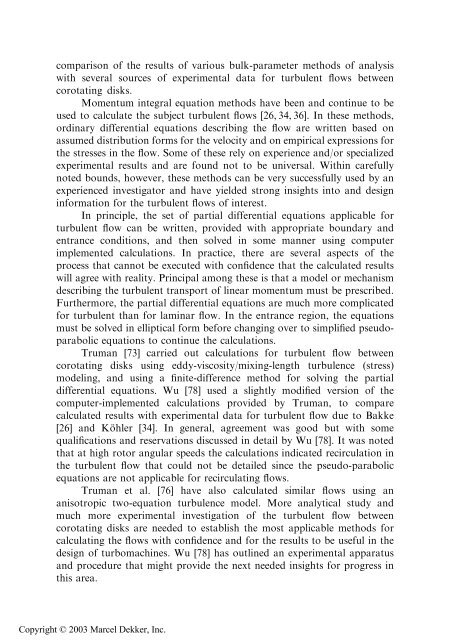Handbook of Turbomachinery, Second Edition
Handbook of Turbomachinery, Second Edition
Handbook of Turbomachinery, Second Edition
You also want an ePaper? Increase the reach of your titles
YUMPU automatically turns print PDFs into web optimized ePapers that Google loves.
comparison <strong>of</strong> the results <strong>of</strong> various bulk-parameter methods <strong>of</strong> analysis<br />
with several sources <strong>of</strong> experimental data for turbulent flows between<br />
corotating disks.<br />
Momentum integral equation methods have been and continue to be<br />
used to calculate the subject turbulent flows [26, 34, 36]. In these methods,<br />
ordinary differential equations describing the flow are written based on<br />
assumed distribution forms for the velocity and on empirical expressions for<br />
the stresses in the flow. Some <strong>of</strong> these rely on experience and/or specialized<br />
experimental results and are found not to be universal. Within carefully<br />
noted bounds, however, these methods can be very successfully used by an<br />
experienced investigator and have yielded strong insights into and design<br />
information for the turbulent flows <strong>of</strong> interest.<br />
In principle, the set <strong>of</strong> partial differential equations applicable for<br />
turbulent flow can be written, provided with appropriate boundary and<br />
entrance conditions, and then solved in some manner using computer<br />
implemented calculations. In practice, there are several aspects <strong>of</strong> the<br />
process that cannot be executed with confidence that the calculated results<br />
will agree with reality. Principal among these is that a model or mechanism<br />
describing the turbulent transport <strong>of</strong> linear momentum must be prescribed.<br />
Furthermore, the partial differential equations are much more complicated<br />
for turbulent than for laminar flow. In the entrance region, the equations<br />
must be solved in elliptical form before changing over to simplified pseudoparabolic<br />
equations to continue the calculations.<br />
Truman [73] carried out calculations for turbulent flow between<br />
corotating disks using eddy-viscosity/mixing-length turbulence (stress)<br />
modeling, and using a finite-difference method for solving the partial<br />
differential equations. Wu [78] used a slightly modified version <strong>of</strong> the<br />
computer-implemented calculations provided by Truman, to compare<br />
calculated results with experimental data for turbulent flow due to Bakke<br />
[26] and Ko¨hler [34]. In general, agreement was good but with some<br />
qualifications and reservations discussed in detail by Wu [78]. It was noted<br />
that at high rotor angular speeds the calculations indicated recirculation in<br />
the turbulent flow that could not be detailed since the pseudo-parabolic<br />
equations are not applicable for recirculating flows.<br />
Truman et al. [76] have also calculated similar flows using an<br />
anisotropic two-equation turbulence model. More analytical study and<br />
much more experimental investigation <strong>of</strong> the turbulent flow between<br />
corotating disks are needed to establish the most applicable methods for<br />
calculating the flows with confidence and for the results to be useful in the<br />
design <strong>of</strong> turbomachines. Wu [78] has outlined an experimental apparatus<br />
and procedure that might provide the next needed insights for progress in<br />
this area.<br />
Copyright © 2003 Marcel Dekker, Inc.
















